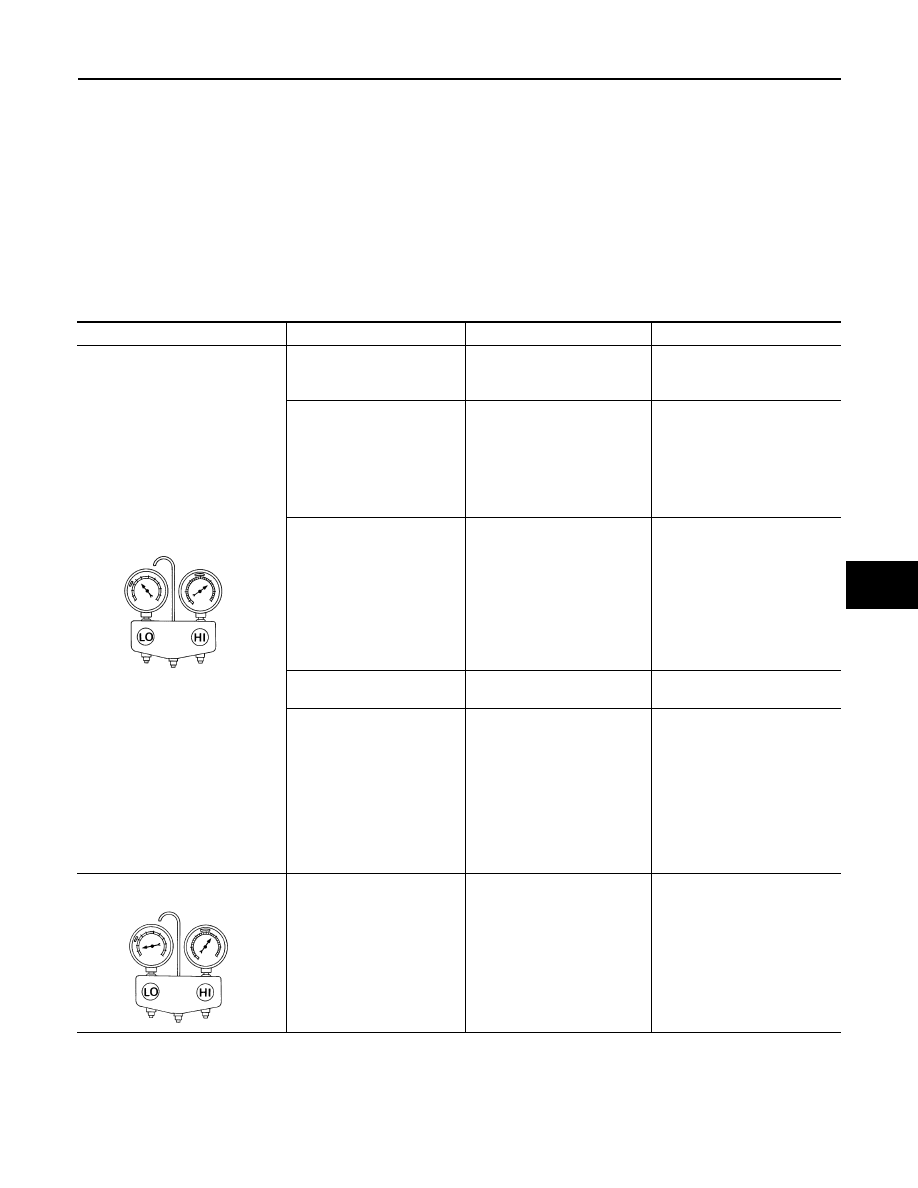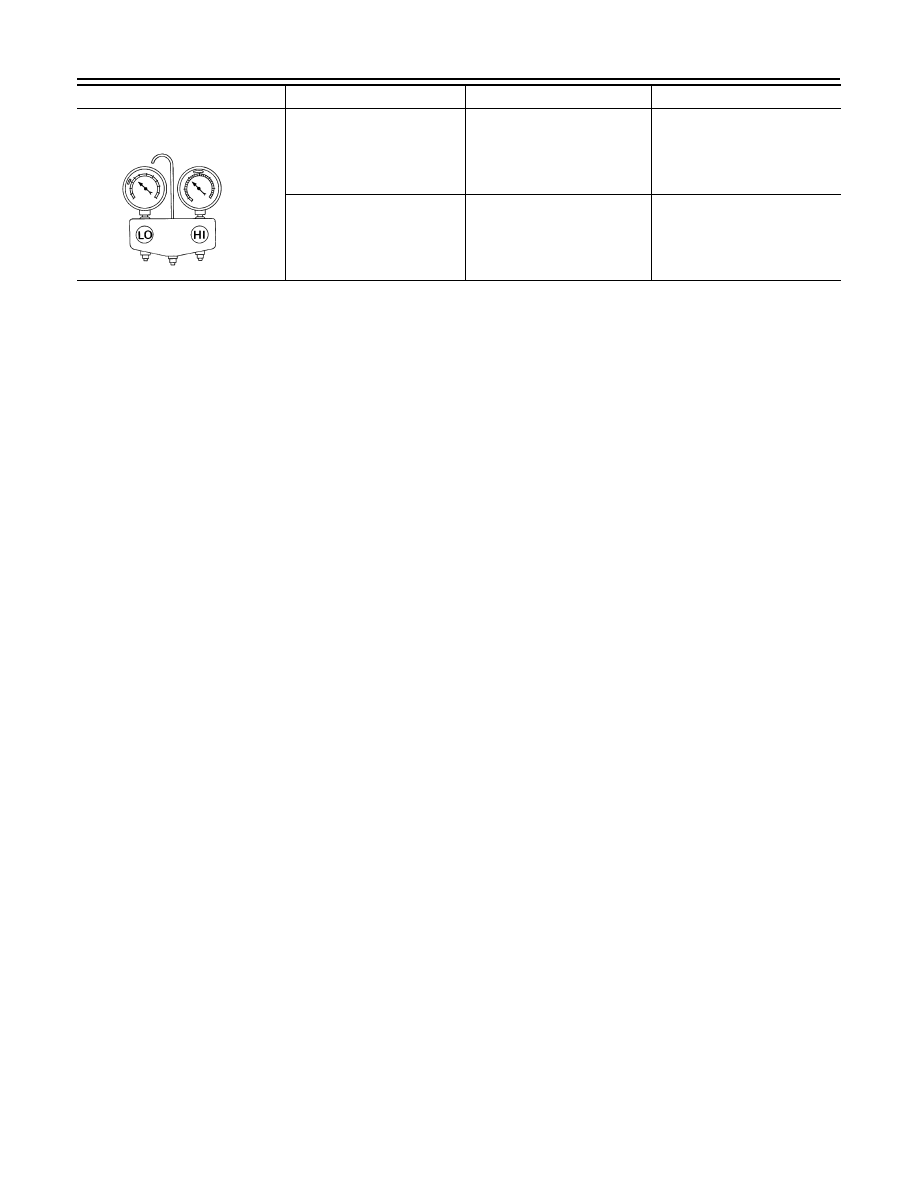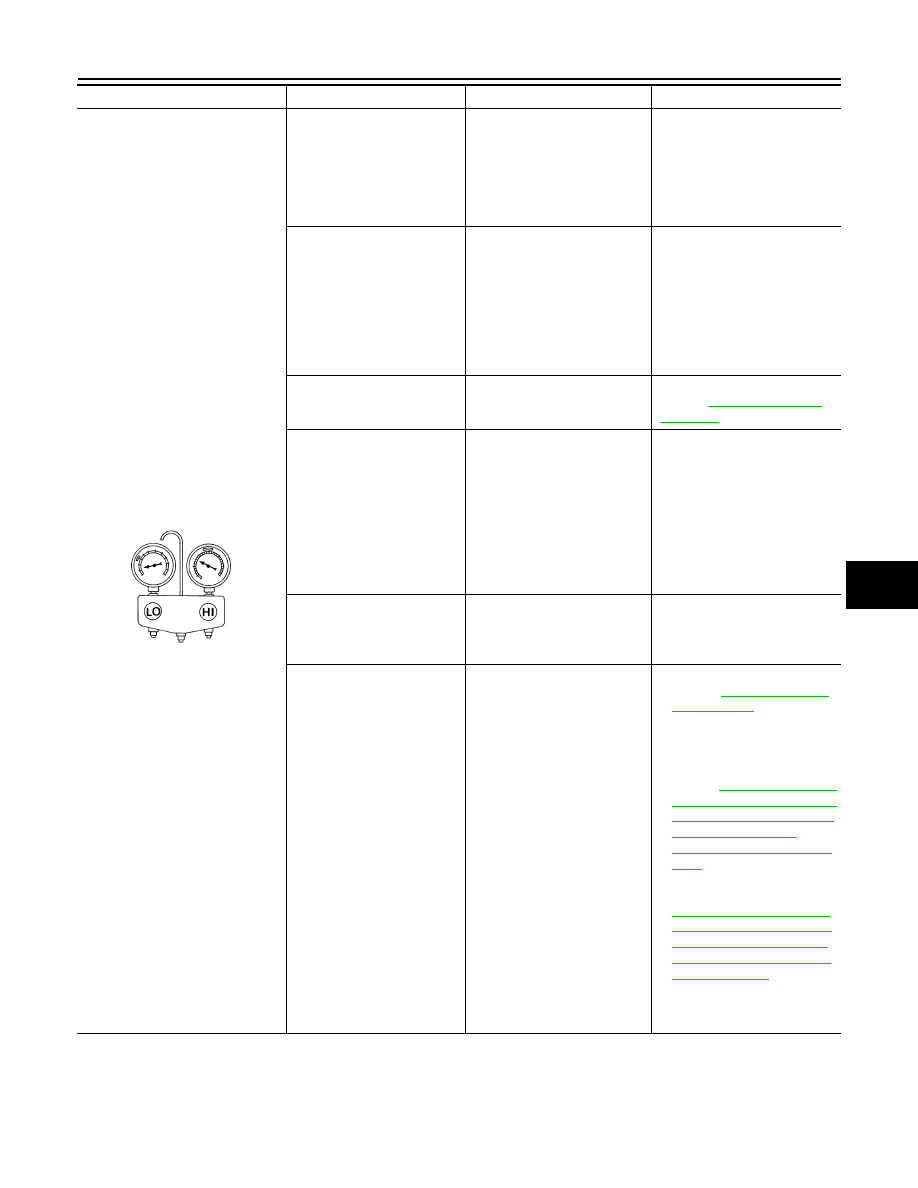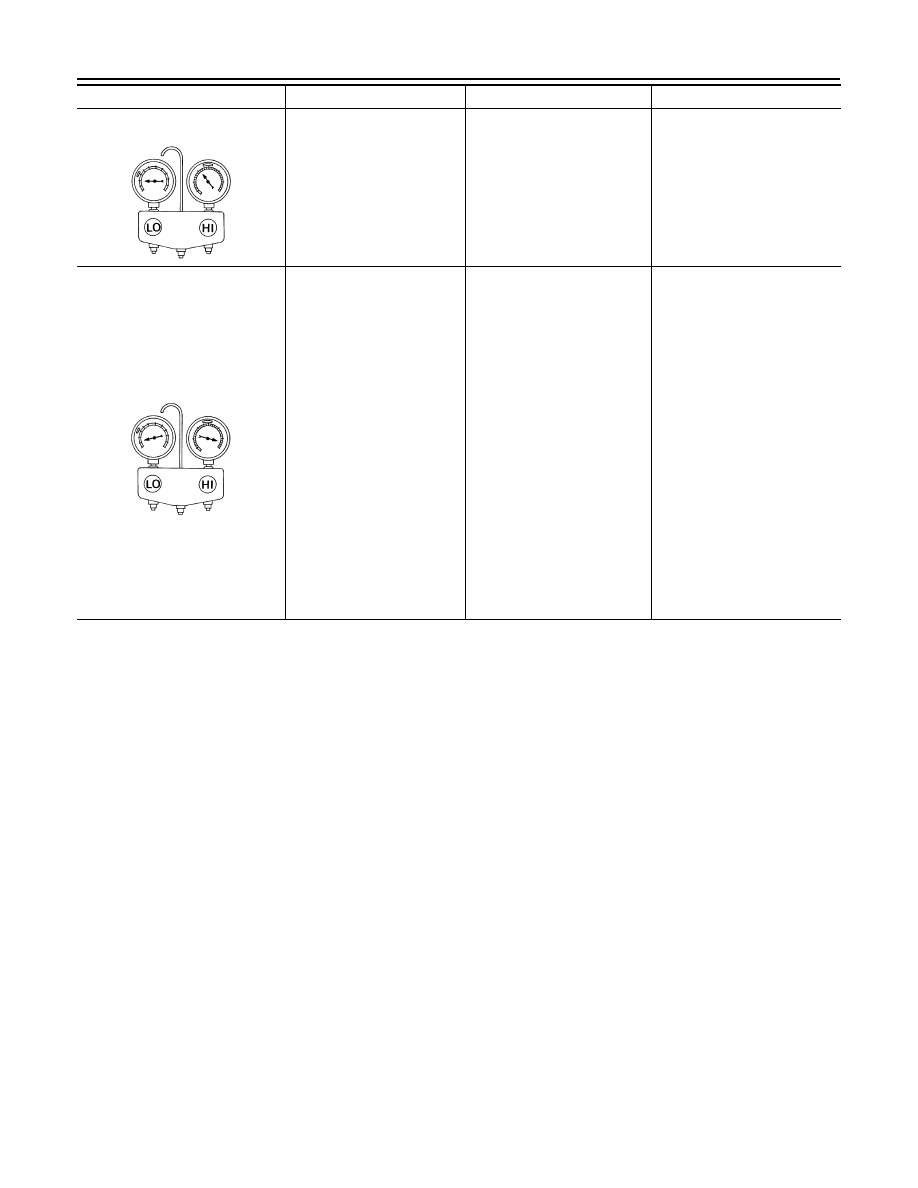Infiniti EX35. Manual — part 887

REFRIGERATION SYSTEM SYMPTOMS
HA-7
< SYMPTOM DIAGNOSIS >
C
D
E
F
G
H
J
K
L
M
A
B
HA
N
O
P
SYMPTOM DIAGNOSIS
REFRIGERATION SYSTEM SYMPTOMS
Trouble Diagnosis For Unusual Pressure
INFOID:0000000003545451
Diagnose using a manifold gauge whenever system’s high and/or low side pressure(s) is/are unusual. The
marker above the gauge scale in the following tables indicates the standard (usual) pressure range. Refer to
above table (Ambient air temperature-to-operating pressure table) since the standard (usual) pressure, how-
ever, differs from vehicle to vehicle.
Symptom Table
INFOID:0000000003545452
Gauge indication
Refrigerant cycle
Probable cause
Corrective action
Both high- and low-pressure sides
are too high.
The pressure returns to nor-
mal is reduced soon after wa-
ter is splashed on condenser.
Excessive refrigerant charge in
refrigeration cycle.
Reduce refrigerant until speci-
fied pressure is obtained.
Air suction by cooling fan is in-
sufficient.
Insufficient condenser cooling
performance.
↓
1.
Condenser fins are
clogged.
2.
Improper fan rotation of
cooling fan.
• Clean condenser.
• Check and repair cooling fan
if necessary.
• Low-pressure pipe is not
cold.
• When compressor is
stopped high-pressure
reading quickly drops by
approximately 196 kPa (2
kg/cm
2
, 28 psi). It then de-
creases gradually thereaf-
ter.
Poor heat exchange in con-
denser
(After compressor operation
stops, high-pressure decreas-
es too slowly).
↓
Air in refrigeration cycle.
Evacuate repeatedly and re-
charge system.
Engine tends to overheat.
Engine cooling systems mal-
function.
Check and repair each engine
cooling system.
• An area of the low-pressure
pipe is colder than areas
near the evaporator outlet.
• Low-pressure pipe is some-
times covered with frost.
• Excessive liquid refrigerant
on low-pressure side.
• Excessive refrigerant dis-
charge flow.
• Expansion valve is open a lit-
tle compared with the speci-
fication.
↓
Improper expansion valve ad-
justment.
Replace expansion valve.
High-pressure side is too high and
low-pressure side is too low.
Upper side of condenser and
high-pressure side are hot,
however, liquid tank is not so
hot.
High-pressure tube or parts lo-
cated between compressor
and condenser are clogged or
crushed.
• Check and repair or replace
malfunctioning parts.
• Check lubricant for contami-
nation.
AC359A
AC360A

HA-8
< SYMPTOM DIAGNOSIS >
REFRIGERATION SYSTEM SYMPTOMS
High-pressure side is too low and
low-pressure side is too high.
High- and low-pressure sides
become equal soon after
compressor operation stops.
Compressor pressure opera-
tion is improper.
↓
Damaged inside compressor
packings.
Replace compressor.
No temperature difference be-
tween high- and low-pressure
sides.
Compressor pressure opera-
tion is improper.
↓
Damaged inside compressor
packings.
Replace compressor.
Gauge indication
Refrigerant cycle
Probable cause
Corrective action
AC356A

REFRIGERATION SYSTEM SYMPTOMS
HA-9
< SYMPTOM DIAGNOSIS >
C
D
E
F
G
H
J
K
L
M
A
B
HA
N
O
P
Both high- and low-pressure sides
are too low.
• There is a big temperature
difference between liquid
tank outlet and inlet. Outlet
temperature is extremely
low.
• Liquid tank inlet and expan-
sion valve are frosted.
Liquid tank inside is slightly
clogged.
• Replace liquid tank.
• Check lubricant for contami-
nation.
• Expansion valve inlet tem-
perature is extremely low
as compared with areas
near liquid tank.
• Expansion valve inlet is
frosted.
• Temperature difference oc-
curs somewhere in high-
pressure side.
High-pressure pipe located be-
tween liquid tank and expan-
sion valve is clogged.
• Check and repair malfunc-
tioning parts.
• Check lubricant for contami-
nation.
Expansion valve and liquid
tank are warm or slightly cool
when touched.
Low refrigerant charge.
↓
Leaking fittings or components.
Check refrigerant for leakages.
Refer to
.
There is a big temperature dif-
ference between expansion
valve inlet and outlet while the
valve itself is frosted.
Expansion valve closes a little
compared with the specifica-
tion.
↓
1.
Improper expansion
valve adjustment.
2.
Malfunctioning expansion
valve.
3.
Outlet and inlet may be
clogged.
• Remove foreign particles by
using compressed air.
• Replace expansion valve.
• Check lubricant for contami-
nation.
An area of the low-pressure
pipe is colder than areas near
the evaporator outlet.
Low-pressure pipe is clogged
or crushed.
• Check and repair malfunc-
tioning parts.
• Check lubricant for contami-
nation.
Air flow volume is not enough
or is too low.
Evaporator is frozen.
• Check intake sensor circuit.
Refer to
.
• Replace compressor.
• Repair evaporator fins.
• Replace evaporator.
• Check blower motor circuit.
LEFT AND RIGHT VENTILA-
TION TEMPERATURE SEP-
ARATELY CONTROL
SYSTEM : Diagnosis Proce-
dure"
(Without left and right
ventilation temperature sepa-
rately control system) or
(With left
and right ventilation tempera-
ture separately control sys-
tem).
Gauge indication
Refrigerant cycle
Probable cause
Corrective action
AC353A

HA-10
< SYMPTOM DIAGNOSIS >
REFRIGERATION SYSTEM SYMPTOMS
Low-pressure side sometimes be-
comes negative.
• Air conditioning system
does not function and does
not cyclically cool the com-
partment air.
• The system constantly
functions for a period of
time after compressor is
stopped and restarted.
Refrigerant does not discharge
cyclically.
↓
Moisture is frozen at expansion
valve outlet and inlet.
↓
Water is mixed with refrigerant.
• Drain water from refrigerant
or replace refrigerant.
• Replace liquid tank.
Low-pressure side becomes nega-
tive.
Liquid tank or front/rear side
of expansion valve’s pipe is
frosted or wet with dew.
High-pressure side is closed
and refrigerant does not flow.
↓
Expansion valve or liquid tank
is frosted.
Leave the system at rest until
no frost is present. Start it again
to check whether or not the mal-
function is caused by water or
foreign particles.
• Cooling is initially okay if wa-
ter is the cause. Then the wa-
ter freezes causing a
blockage. Drain water from
refrigerant or replace refriger-
ant.
• Remove expansion valve and
remove the particles with dry
and compressed air (not shop
air) if due to foreign particles.
• Replace expansion valve if
either of the above methods
cannot correct the malfunc-
tion.
• Replace liquid tank.
• Check lubricant for contami-
nation.
Gauge indication
Refrigerant cycle
Probable cause
Corrective action
AC354A
AC362A

Нет комментариевНе стесняйтесь поделиться с нами вашим ценным мнением.
Текст